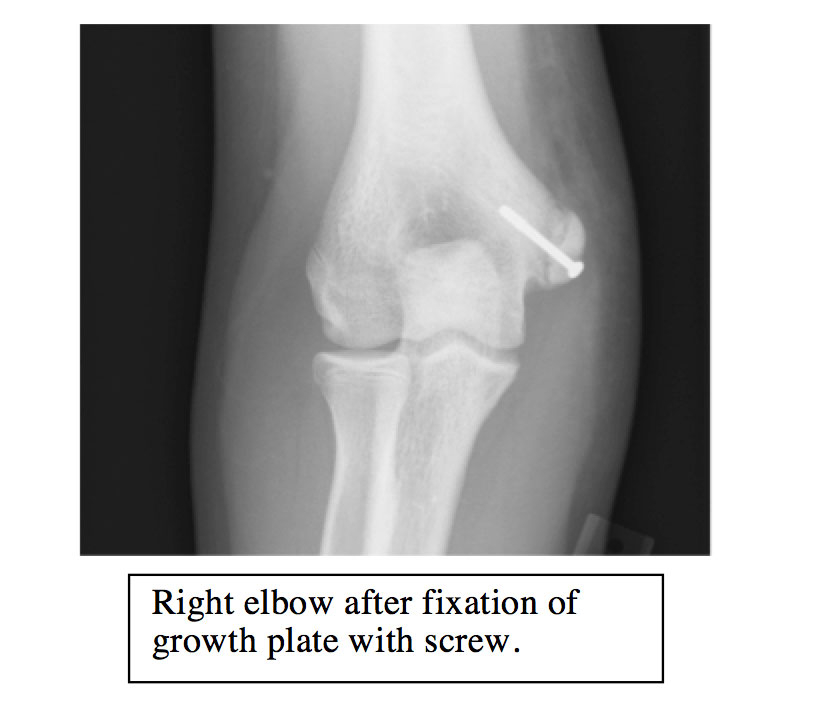As spring is now in full swing, many baseball players will be hitting the diamond. Unfortunately, overuse injuries often come along with America’s favorite pastime. In youth baseball, there are many overuse injuries that can occur in throwing athletes, and treatments will vary depending on age and body area. Overuse injuries in youth baseball include both Little League Shoulder and Little League Elbow.
Little League Shoulder (Proximal Humerus Epiphysitis) is an irritation of the growth plate near the end of the humerus or the long bone in the upper arm where it meets the shoulder proximally. The growth plate has several muscle tendons attached to it and they are responsible for the rotational movements of the shoulder. This injury is caused by repetitive overhand throwing, more common in pitchers and catchers than field players. The athlete complains of pain in the shoulder or upper arm area that does not get better with rest or changing position. The irritation in the growth plate can become so severe that it causes the growth plate to widen due to the stress placed on the area, and in some rare cases a fracture through the growth plate can be seen. (see picture)

Evaluation: The proper diagnosis of this injury begins with a thorough examination of the shoulder and x-rays. Many times the x-rays show a widening or opening in the growth plate at the end of the Humerus or upper arm bone. Often times x-rays of both shoulders are taken so the growth plates in both shoulders can be compared looking for any discrepancies in their width. A MRI is recommended to see if there is any swelling (edema) around the growth plate.

Treatment: Rest, Rest, Rest! Avoiding throwing for six to twelve weeks commonly reduces pain. Many times a rehabilitation program is implemented to strengthen and increase the endurance of the shoulder and trunk muscles. When cleared by your physician, a structured return to throwing program is initiated to gradually increase the stresses around the shoulder and allow for a healthy return to throwing activities.
Little League Elbow (Medial Epicondylar Apophysitis) is an irritation of the growth plate on the inner side of the elbow (medial). It is most common in young baseball pitchers between the ages of 9 to 14 years of age. This injury is also caused by repetitive overhand throwing, most common in pitchers, but can occur at any field position. The growth plate has several muscles that attach to it as well including the muscles that flex the wrist as well as the ligaments that stabilize the elbow. These muscles can place significant force on the growth plate with motion and lead to irritation of the growth plate. In some cases, the growth plate actually pulls away from the bone of the upper arm. (see picture)

Evaluation: A thorough examination of the elbow is performed, assessing the muscles and ligaments of the elbow. X-rays are performed of both elbows to compare the throwing arm to the non-throwing arm. The x-rays can show a widening at the growth plate, a growth plate gap, or a complete separation of the growth plate from the bone called an avulsion. (see picture)

Treatment: Rest-- six to twelve weeks of rest. Once the elbow is pain free and has a normal physical exam, a structured return to throwing program is initiated. If the growth plate is pulled away from the bone (avulsion fracture), surgery is recommended to stabilize the fracture with screws to allow the bone to heal. (see picture)

Prevention:There is hope however; with some modifications many overuse injuries can be prevented. World renowned orthopedic surgeon Dr. James Andrews and The American Sports Medicine Institute in Birmingham, Alabama have been doing research for years on the most effective pitch mechanics for young pitchers. Through this research USA Baseball medical and safety advisory committee has made several recommendations to help young baseball players avoid injuries. It is recommend that pitchers do not begin to throw a curve ball before the age of 13, but instead focus on good fastball mechanics. Also the importance of pitch counts cannot be stressed enough when it comes to overuse injuries. Other ways to prevent injury are to never pitch through pain, pitch for 8-9 months per year maximum, and play more than one position and more than one sport per year. Being a diversified athlete allows for an increase in hand eye coordination and allows different body areas required for different sports to rest during their given off-season.
Follow these recommendations and kids everywhere can have a safe and uneventful summer of baseball, “Playball!”
Here is a great example of Pitch Counts from Dr. Andrews: For Info on Sports prevention and Pitch counts visit http://www.stopsportsinjuries.org/
Maximum Pitch Counts
| Age | Pitches/Game |
| 7-8 | 50 |
| 9-10 | 75 |
| 11-12 | 85 |
| 13-16 | 95 |
| 17-18 | 105 |
Source: Little League Baseball
Rest Periods Required
| Ages 14 and under | Ages 15–18 | Required # of Rest Pitches |
| 66+ | 76+ | 4 calendar days |
| 51–65 | 61–75 | 3 calendar days |
| 36–50 | 46–60 | 2 calendar days |
| 21–35 | 31–45 | 1 calendar day |
| 1-20 | 1–30 | None |
Source: Little League Baseball
Source: From work by James R. Andrews, MD, and Glenn S. Fleisig, PhD


